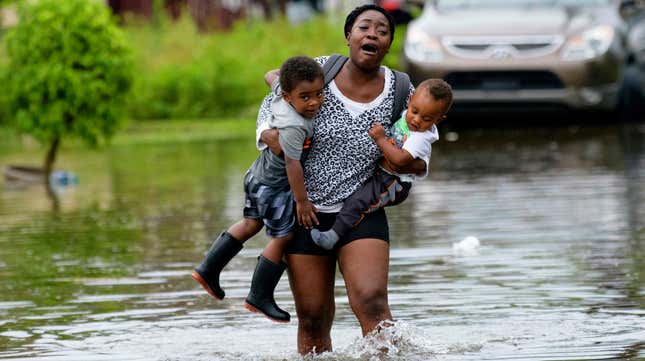
Tropical Storm Barry just officially formed this morning, but water is already bearing down on New Orleans. The situation looks bad, to say the least, and we at Earther will be following it closely as the city and state of Louisiana prepare for what is forecasted to become a hurricane by the weekend.
New Orleans, known for its jazz and po’boys, started flooding yesterday ahead of the tropical storm system that’s still getting organized in the Gulf. The surrounding region is expected to receive up to 20 inches more of rain through the weekend, in addition to facing the threat of river flooding and overtopped levees. So far, Louisiana Governor John Bel Edwards has issued a state of emergency, and officials have begun to close floodgates in and around New Orleans. More than 200 should be closed by Friday, reports the Times-Picayune.
The National Weather Service isn’t expecting the storm to become all that strong in terms of wind speeds, but damage isn’t just about how much the wind manages to blow around. It’s about the water, too, as Louisiana is already seeing. The storm should become a hurricane by Saturday.
The coast is already under hurricane watch. Mandatory evacuations are underway in Plaquemines Parish, which hugs the water. A third of the region’s oil production has shut down, reports Reuters, as industry prepares for the impending storm. Gasoline prices rose a bit as a result.
Experts are having to warn residents to stay clear of the floodwaters as they could carry harmful toxins or chemicals. Plus, sewers are already backing up, and that water has nowhere to go but up. Public health is always a concern when these type of weather events occur as industrial facilities often become compromised. But what’s really at stake this time around are the city’s levees, which failed when Hurricane Katrina hit in 2005.

The Mississippi River should crest at about 20 feet Friday night, but some levees in the Lower Ninth Ward sit below that, according to the Times-Picayune. As luck would have it, the Army Corps of Engineers, which is in charge of the nation’s levees, doesn’t have the $1.9 billion needed to repair the systems that were damaged in the Midwest after the spring flooding it saw earlier this year. Soon to be tropical storm Barry is pushing the water levels in our nation’s rivers even higher, per E&E News.
Earther will be issuing updates as the situation unfolds.
Update, 11 a.m. ET: Tropical Storm Barry is official. The National Weather Service announced that the disturbance has upgraded to a tropical storm, bringing it one step closer to a hurricane. Wind speeds have reached 40 miles per hour, and waters are rising. A tornado or two may even appear between tonight and Friday in southern Louisiana and Mississippi.
The article’s text has been updated to reflect the fact that Barry is now a named tropical storm.
Update, 2 p.m. ET: The city of New Orleans will not be issuing evacuations before landfall of the growing storm as the city typically waits for a storm to become a Category 3 hurricane before doing so. Tropical Storm Barry is not expected to become that strong on the Saffir-Simpson Hurricane Wind Scale. The city has also confirmed that all Immigration and Customs Enforcement has been suspended through the weekend to ensure undocumented immigrants are protected as they prepare and respond to the situation.
Governor Edwards held a press conference where his team announced that the state is prepared for the post-storm response with up to 3,000 National Guard members on standby. This will be the first time that a hurricane forms over the state with the Mississippi River already elevated, Edwards said.
“We are encouraging everyone to take this very, very seriously,” he said at the press conference.
Update July 12, 2019, 9 a.m. ET: Louisianans have the support of President Donald Trump. He issued a federal emergency declaration last night after Governor Edwards sent him a request for assistance from the Army Corps of Engineers, the U.S. Coast Guard, Civil Air Patrol, Fish and Wildlife Service, and the Department of Agriculture. This is not only in preparation for the storm but for what officials expect will come after, including crop damage.
Currently, the National Hurricane Center’s forecast doesn’t show Tropical Storm Barry developing into a hurricane, but that’s still possible in the next 24 hours. The storm’s current maximum wind speed is some 50 miles per hour with the potential to reach 70 miles per hour by tomorrow.